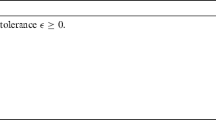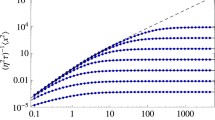Abstract
Animal movement often exhibits changing behavior because animals often alternate between exploring, resting, feeding, or other potential states. Changes in these behavioral states are often driven by environmental conditions or the behavior of nearby individuals. We propose a model for dependence among individuals’ behavioral states. We couple this state switching with complex discrete-time animal movement models to analyze a large variety of animal movement types. To demonstrate this method of capturing dependence, we study the movements of ants in a nest. The behavioral interaction structure is combined with a spatially varying stochastic differential equation model to allow for spatially and temporally heterogeneous collective movement of all ants within the nest. Our results reveal behavioral tendencies that are related to nearby individuals, particularly the queen, and to different locations in the nest.



Similar content being viewed by others
References
Albert, J. H., & Chib, S. (1993), “Bayesian analysis of binary and polychotomous response data”. Journal of the American Statistical Association, 88(422), 669–679.
Blackwell, P. (1997), “Random diffusion models for animal movement”. Ecological Modelling, 100, 87–102.
Blackwell, P. G., Niu, M., Lambert, M. S., & LaPoint, S. D. (2016), “Exact Bayesian inference for animal movement in continuous time”. Methods in Ecology and Evolution, 7(2), 184–195.
Brillinger, D. R., Preisler, H. K., Ager, A. A., & Kie, J.G. (2001), “The use of potential functions in modelling animal movement,” in Selected Works of David Brillinger ed. G. Peter, D. Brillinger, New York, NY: Springer, pp. 385–409.
Brillinger, D. R., Preisler, H. K., Ager, A. A., Kie, J. G., & Stewart, B. S. (2002), “Employing stochastic differential equations to model wildlife motion”. Bulletin of the Brazilian Mathematical Society, 33(3), 385–408.
Couzin, I. D., Krause, J., James, R., Ruxton, G. D., & Franks, N. R. (2002), “Collective memory and spatial sorting in animal groups”. Journal of Theoretical Biology, 218(1), 1–11.
Flegal, J., Haran, M., & Jones, G. (2008), “Markov chain Monte Carlo: Can we trust the third significant figure?”. Statistical Science, 23, 250–260.
Fox, E. B., Sudderth, E. B., Jordan, M. I., & Willsky, A. S. (2011), “A sticky HDP-HMM with application to speaker diarization”. The Annals of Applied Statistics, 5(2A), 1020–1056.
Franks, N. R., Bryant, S., Griffiths, R., & Hemerik, L. (1990), “Synchronization of the behaviour within nests of the ant Leptothorax acervorum (fabricius)-I. Discovering the phenomenon and its relation to the level of starvation”. Bulletin of Mathematical Biology, 52(5), 597–612.
Hanks, E. M., Johnson, D. S., & Hooten, M. B. (2017), “Reflected stochastic differential equation models for constrained animal movement”. Journal of Agricultural, Biological, and Environmental Statistics. doi:10.1007/s13253-017-0291-8.
Johnson, D., London, J., Lea, M., & Durban, J. (2008), “Continuous-time correlated random walk model for animal telemetry data”. Ecology, 89, 1208–1215.
Jones, G., Haran, M., Caffo, B., & Neath, R. (2006), “Fixed-width output analysis for Markov chain Monte Carlo”. Journal of the American Statistical Association, 101, 1537–1547.
Langrock, R., Hopcraft, J., Blackwell, P., Goodall, V., King, R., Niu, M., Patterson, T., Pedersen, M., Skarin, A., & Schick, R. (2014), “Modelling group dynamic animal movement”. Methods in Ecology and Evolution, 5, 190–199.
Langrock, R., King, R., Matthiopoulos, J., Thomas, L., Fortin, D., & Morales, J. M. (2012), “Flexible and practical modeling of animal telemetry data: hidden Markov models and extensions”. Ecology, 93(11), 2336–2342.
Mann, R. (2011), “Bayesian inference for identifying interaction rules in moving animal groups”. PloS ONE, 6, 1–10.
Milgram, S., Bickman, L., & Berkowitz, L. (1969), “Note on the drawing power of crowds of different size”. Journal of Personality and Social Psychology, 13, 79.
Morales, J. M., Haydon, D. T., Frair, J., Holsinger, K. E., & Fryxell, J. M. (2004), “Extracting more out of relocation data: building movement models as mixtures of random walks”. Ecology, 85(9), 2436–2445.
Perna, A., Grégoire, G., & Mann, R. (2014), “On the duality between interaction responses and mutual positions in flocking and schooling”. Movement Ecology, 2, 22.
Preisler, H. K., Ager, A. A., Johnson, B. K., & Kie, J. G. (2004), “Modeling animal movements using stochastic differential equations”. Environmetrics, 15(7), 643–657.
Quevillon, L. E., Hanks, E. M., Bansal, S., and Hughes, D. P. (2015), “Social, spatial, and temporal organization in a complex insect society,” Scientific Reports, 5, 13393.
Russell, J. C., Hanks, E. M., & Haran, M. (2016a), “Dynamic models of animal movement with spatial point process interactions”. Journal of Agricultural, Biological, and Environmental Statistics, 21(1), 22–40.
Russell, J. C., Hanks, E. M., Haran, M., & Hughes, D. P. (2016b), “A spatially-varying stochastic differential equation model for animal movement”. arXiv:1603.07630.
Scharf, H. R., Hooten, M. B., Fosdick, B. K., Johnson, D. S., London, J. M., & Durban, J. W. (2015), “Dynamic social networks based on movement”. arXiv:1512.07607.
Seeley, T. D. (2009), The wisdom of the hive: the social physiology of honey bee colonies, Harvard University Press.
Treherne, J., & Foster, W. (1981), “Group transmission of predator avoidance behaviour in a marine insect: the Trafalgar effect”. Animal Behaviour, 29(3), 911–917.
Vicsek, T., Czirók, A., Ben-Jacob, E., Cohen, I., & Shochet, O. (1995), “Novel type of phase transition in a system of self-driven particles”. Physical Review Letters, 75(6), 1226.
Vicsek, T., & Zafeiris, A. (2012), “Collective motion”. Physics Reports, 517(3), 71–140.
Ward, A. J., Sumpter, D. J., Couzin, I. D., Hart, P. J., & Krause, J. (2008), “Quorum decision-making facilitates information transfer in fish shoals”. Proceedings of the National Academy of Sciences, 105(19), 6948–6953.
Acknowledgements
This research is supported by the NSF grant EEID 1414296 and NIH GM116927-01. We are grateful to Ryan Bringenberg and many undergraduates at Penn State for their work collecting the movement data.
Author information
Authors and Affiliations
Corresponding author
Appendices
Appendix A: Model Parameters
A summary of all the model parameters is presented in Table 3.
Prior distributions for all parameters are given in Table 4.
Appendix B: Details on Markov Chain Monte Carlo Inference
As discussed in Sect. 4, estimating the discrete behavioral states improves the computational efficiency of Bayesian inference. If we assume that the latent states are known, inference can be separated into several separate parts (five in this particular case.) Each of the parts corresponds to modeling one particular aspect of ant movement. Details for updating all model parameters within separate Markov chains for the ant movement data are given below. Full-conditional distributions are given for parameters when Gibbs updates are used. Each separate part can be adjusted depending on the particular movement that is being modeled.
-
1.
Parameters for moving ants
-
\(\beta \)—Gibbs update
$$\begin{aligned} \beta&\sim \text {N}_{+}\left( \frac{a}{b} , \frac{c}{b} \right) [0, \infty ]\\ a&=10^4 \sum _{s_{i,j}=M} M^{-2}(x_{t-1,j}, y_{t-1,j}) * \\&\left( \left( x_{t-1,j}\left( 1 + \frac{M(x_{t-1,j},y_{t-1,j})}{M(x_{t-2,j},y_{t-2,j})} \right) - x_{t,j} - x_{t-2,j}\frac{M(x_{t-1,j},y_{t-1,j})}{M(x_{t-2,j},y_{t-2,j})} \right) \right. \\&\left( x_{t-1,j} \Delta \frac{M(x_{t-1,j},y_{t-1,j})}{M(x_{t-2,j},y_{t-2,j})} - x_{t-2,j} \Delta \frac{M(x_{t-1,j},y_{t-1,j})}{M(x_{t-2,j},y_{t-2,j})} \right. \\&\quad \left. - \Delta ^2 M(x_{t-1,j},y_{t-1,j}) \frac{\mathrm{d}H(x_{t-2,j}, y_{t-2,j})}{\mathrm{d}x} \right) \\&+\left( y_{t-1,j}\left( 1 + \frac{M(x_{t-1,j},y_{t-1,j})}{M(x_{t-2,j},y_{t-2,j})} \right) - y_{t,j} - y_{t-2,j}\frac{M(x_{t-1,j},y_{t-1,j})}{M(x_{t-2,j},y_{t-2,j})} \right) \\&\left. \left( y_{t-1,j} \Delta \frac{M(x_{t-1,j},y_{t-1,j})}{M(x_{t-2,j},y_{t-2,j})} - y_{t-2,j} \Delta \frac{M(x_{t-1,j},y_{t-1,j})}{M(x_{t-2,j},y_{t-2,j})} \right. \right. \\&\quad \left. \left. - \Delta ^2 M(x_{t-1,j},y_{t-1,j}) \frac{\mathrm{d}H(x_{t-2,j}, y_{t-2,j})}{\mathrm{d}y} \right) \right) + \sigma ^2 \Delta ^3\\&b=10^4 \sum _{s_{i,j}=M} M^{-2}(x_{t-1,j}, y_{t-1,j}) * \\&\left( \left( x_{t-1,j} \Delta \frac{M(x_{t-1,j},y_{t-1,j})}{M(x_{t-2,j},y_{t-2,j})} - x_{t-2,j} \Delta \frac{M(x_{t-1,j},y_{t-1,j})}{M(x_{t-2,j},y_{t-2,j})}\right. \right. \\&\quad \left. \left. - \Delta ^2 M(x_{t-1,j},y_{t-1,j}) \frac{\mathrm{d}H(x_{t-2,j}, y_{t-2,j})}{\mathrm{d}x} \right) ^2 \right. \\&+\left( y_{t-1,j} \Delta \frac{M(x_{t-1,j},y_{t-1,j})}{M(x_{t-2,j},y_{t-2,j})} - y_{t-2,j} \Delta \frac{M(x_{t-1,j},y_{t-1,j})}{M(x_{t-2,j},y_{t-2,j})} \right. \\&\left. \left. - \Delta ^2 M(x_{t-1,j},y_{t-1,j}) \frac{\mathrm{d}H(x_{t-2,j}, y_{t-2,j})}{\mathrm{d}y} \right) ^2 \right) + \sigma ^2 \Delta ^3\\ c&=10^4 2\sigma ^2 \Delta ^3 \end{aligned}$$ -
\(\varvec{\gamma }\)—Gibbs update
\(\varvec{\gamma } \sim \text {N}(\cdot , \cdot )\) with mean \(\left( \sum _{s_{t,j}=M} \varvec{a}_{i,j} + \tau _{\gamma } \left( \varvec{D} -\rho _{\gamma } \varvec{Q} \right) \right) ^{-1} \left( \sum _{s_{t,j}=M} \varvec{b}_{i,j} \right) \) and variance \(\left( \sum _{s_{t,j}=M} \varvec{a}_{i,j} + \tau _{\gamma } \left( \varvec{D} -\rho _{\gamma } \varvec{Q} \right) \right) ^{-1}\)
$$\begin{aligned} \varvec{a}_{i,j}&=\frac{\beta ^2 \Delta }{\sigma ^2} \Phi '_x (x_{t-2,j}, y_{t-2,j})\Phi _x (x_{t-2,j}, y_{t-2,j}) \\&\quad + \frac{\beta ^2 \Delta }{\sigma ^2} \Phi '_y (x_{t-2,j}, y_{t-2,j})\Phi _y (x_{t-2,j}, y_{t-2,j})\\ \varvec{b}_{i,j}&=\frac{\beta }{\sigma ^2 \Delta M(x_{t-1,j}, y_{t-1, j})} * \\&\left( \Phi '_x (x_{t-2,j}, y_{t-2,j}) \left( x_{t,j} - x_{t-1,j}(2-\beta \Delta ) -x_{t-2,j} (\beta \Delta -1) \right. \right. \\&\quad \left. \left. - \beta \Delta ^2 M(x_{t-1,j}, y_{t-1, j}) \frac{d}{dx}R(x_{i,j}, y_{i,j}) \right) \right. \\&\quad \left. +\Phi '_y (x_{t-2,j}, y_{t-2,j})\left( y_{t,j} - y_{t-1,j}(2-\beta \Delta ) -y_{t-2,j} (\beta \Delta -1) \right. \right. \\&\quad \left. \left. - \beta \Delta ^2 M(x_{t-1,j}, y_{t-1, j}) \frac{d}{dy}R(x_{i,j}, y_{i,j}) \right) \right) \end{aligned}$$where \(\Phi _x (x_{t,j}, y_{t,j})\) and \(\Phi _y (x_{t,j}, y_{t,j})\) are the derivatives of the B-spline Basis functions \(\Phi _ (x_{t,j}, y_{t,j})\) with respect to x and y.
-
\(\tau _{\gamma }\)—Gibbs update
\(\tau ^2_{\gamma } \sim \text {IG}( \frac{1}{2}N_{Basis} + 1, \frac{1}{2}\varvec{\gamma }' \left( \varvec{D} -\rho _{\gamma } \varvec{Q} \right) \varvec{\gamma } + 1 )\)
where \(N_{Basis}\) is the number of basis functions used for estimating the potential surface
-
\(\rho _{\gamma }\)—Metropolis-Hastings Update
-
\(r_1\) - Metropolis-Hastings Update
-
\(\alpha _1\) - Metropolis-Hastings Update
-
\(\alpha _2\) - Metropolis-Hastings Update
-
-
2.
Parameter for non-moving ants
-
\(\kappa ^2\)—Gibbs update
\(\kappa ^2 \sim \text {IG}(N_{N-M}+ 10^{-6}, \sum _{s_{t,j} = N} \left( (x_{t,j} - x_{t-1,j} )^2 + (y_{t,j} - y_{t-1,j})^2 \right) + 10^{-6} )\)
where \(N_{N-M}\) is the total number of observations of non-moving ants.
-
-
3.
Parameters for ants entering the observation window.
-
\(\mu _{x_O}\)—Gibbs update
\(\mu _{x_O} \sim \text {N} \left( \frac{10^4\sum _{RE} x_{t,j}}{10^4 N_{RE} + 1}, \frac{10^4}{10^4 N_{RE} + 1} \right) \)
where the sum is taken over all re-entry observations and \(N_{RE}\) represents the number of re-entry observations.
-
\(\mu _{y_O}\)—Gibbs update
\(\mu _{y_O} \sim \text {N} \left( \frac{10^4\sum _{RE} y_{t,j}}{10^4 N_{RE} + 1}, \frac{10^4}{10^4 N_{RE} + 1} \right) \)
where the sum is taken over all re-entry observations and \(N_{RE}\) represents the number of re-entry observations.
-
\(\kappa ^2_{x_O}\)—Gibbs update
\(\kappa ^2_{x_O} \sim \text {IG}\left( \frac{1}{2} N_{RE}+ 10^{-2}, \frac{1}{2} \sum _{RE}( x_{t,j}- \mu _{x_O})^2 + 10^{-2} \right) \)
where the sum is taken over all re-entry observations and \(N_{RE}\) represents the number of re-entry observations.
-
\(\kappa ^2_{y_O}\)—Gibbs update
\(\kappa ^2_{y_O} \sim \text {IG}\left( \frac{1}{2} N_{RE}+ 10^{-2}, \frac{1}{2} \sum _{RE}( y_{t,j}- \mu _{y_O})^2 + 10^{-2} \right) \)
where the sum is taken over all re-entry observations and \(N_{RE}\) represents the number of re-entry observations.
-
\(p_{OM}\)—Gibbs update
\(\kappa ^2_{x_O} \sim \text {Beta}\left( N_{RE}+ 10^{-3}, N_{OO} + 10^{-3} \right) \)
where \(N_{RE}\) represents the number of re-entry observations and \(N_{OO}\) represents the number of individuals that stay outside for consecutive observations.
-
-
4.
Parameters for behavioral state transitions of moving ants
-
\(\varvec{\eta }_M\)—Gibbs update
See Albert and Chib (1993) for additional details on auxiliary variable method
-
-
5.
Parameters for behavioral state transitions of non-moving ants.
-
\(\varvec{\eta }_N\)—Gibbs update
See Albert and Chib (1993) for additional details on auxiliary variable method
-
Rights and permissions
About this article
Cite this article
Russell, J.C., Hanks, E.M., Modlmeier, A.P. et al. Modeling Collective Animal Movement Through Interactions in Behavioral States. JABES 22, 313–334 (2017). https://doi.org/10.1007/s13253-017-0296-3
Received:
Accepted:
Published:
Issue Date:
DOI: https://doi.org/10.1007/s13253-017-0296-3




